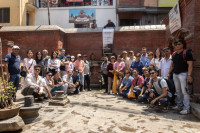Culture & Lifestyle
The traditional weapon that is losing its edge
The popular Bhojpure khukuris are exported all around the world, particularly to the US, the UK, Germany, France, Italy, and Spain. But in recent years, its production has been largely stifled.
Alisha Shrestha
Ganesh Gajmer rises with dawn. He freshens up, prepares for himself a morning snack and then enters his workshop, which is right behind his house. Inside, he heats the furnace, and then sits down to sharpen khukuris and other agricultural tools, like sickle, spade and hoe, all day. This has been the 55-year-old’s daily routine for the last four decades.
Gajmer, who inherited the profession from his ancestors, is one of the few people in Bhojpur still producing the famous ‘Bhojpure khukuri’, a type of traditional Nepali weapon popularised globally due to its usage by British Gurkhas. But with the advancement of weaponry, young people’s disinterest in ancestral occupation and scarcity of woodfire to make coal, an imperative ingredient in crafting the traditional weapon, has led to Bhojpure khukuri becoming a scarce possession.
“Every month, we get around 500-2,000 people asking for khukuris. But due to lack of raw materials, we cannot even produce that,” says Gajmer.
In order to create a khukuri, you first need to determine the amount and type of steel you need. And that depends on what kind of khukuri a customer wants. Bhojpure khukuris come in different variations, such as Baduna, Banspate and Sirupate. The dimensions, shape and thickness of the blade of these variations of khukuri vary according to the intended tasks of the weapons as well as the region of their origin. Baduna is thick and wide. Sirupate is sleek with a sharp tip, and is shaped like a leaf. Banspate is thick and shaped like a bamboo leaf.
In order to wield a khukuri, the metal needs to be heated inside an oven filled with coal. After the metal is heated, it is hammered until the required thickness and shape is achieved. The metal is then shined with the use of chemicals and lastly the blade is sharpened.
Coal is imperative in forging a khukuri, but due to recent forest conservation laws, which restrict open access to wood, blacksmiths like Gajmer have been facing difficulty producing the traditional weapon. If the difficulty pertains, Bhojpure khukuri will soon be on the verge of extinction, says Gajmer.
The blacksmiths in Bhojpur claim that Bhojpure khukuri is more popular, both nationally and internationally, than khukuris made in other districts. But despite its importance, its production has been largely stifled in recent years, says Gajmer.

In Bhojpur alone, blacksmiths from around the districts like Kot, Dalgau, Gogane, Khawa, Khairang, Bhokhim, Dawa, Timma, Dingla, Deurali, Jarayotaar and 35 other places are known for producing the famous khukuri. The district headquarters hosts two metal work factories, specifically to forge Bhojpure khukuris.
Bhojpure khukuris have been exported in millions of rupees to Dharan, Biratnagar, Kathmandu as well as to China, Bangladesh, Pakistan, Brunai, Singapore, Hongkong, Japan, Korea, and the United Kingdom since the 90s. The khukuri manufacturers say that there is still a very high demand from neighbouring countries like India, China, Singapore, Hongkong, Bahrain, Japan, and Korea.
“But the lack of open trade policies has reduced the export of khukuris,” says industrialist Hira Shrestha.
Shrestha says that the government too hasn’t helped much with promoting and preserving these khukuris. It is yet to come up with plans and policies that will help promote this industry nationally as well as internationally. It has also shown no interest in establishing any industries and factories to manufacture khukuris, he says.
According to him, in neighbouring countries like India and China, there is a partial ban on khukuris. This is because khukuris are considered as weapons, but at the same time, swords and spears are completely legal. “The government should be able to have talks with the representatives of both countries to increase the export of khukuris,” he says.
The locals believe that khukuris were made in Bhojpur from as early as 1908. In 1970, when then King Mahendra visited Bhojpur, a local blacksmith Singh Bahadur Bishwakarama ‘Sine’ gifted a khukuri to the king. Impressed by his ability to make khukuris, King Mahendra awarded Rs1,000 to Bishwakarma. After that, Bhojpure khukuris found more fame across the national and international market.
In recent years, Bhojpure khukuris have also become popular decorative and gift options. According to local manufacturers, around 80 percent of khukuris manufactured here are used for gifts and decorations and the rest is used for household purposes. Domestic and foreign tourists also get one as a souvenir from the district. Khukuris ranging from 4 inches to 2 feet are produced in the district. Popular for its attractive and decorative handles, these are also exported to the US, the UK, Germany, France, Italy, and Spain among other countries.
But while people from other districts and foreign countries seem interested in Bhojpur’s prized possession, the youth in the district are not charmed by it. As this profession requires a lot of effort and one is forced to work near coals, most youth who were in this profession have opted for foreign employment instead, says Ghanshyam Bishwakarma from Bhaisipanka of Bhojpur municipality. “There is also a dearth of skilled technicians who can manufacture the famed khukuri,” he says.
Without government intervention, the future for these khukuris is bleak. “If the government can make this occupation more professional, it can create job opportunities for thousands of youths inside the country,” he says.




 16.66°C Kathmandu
16.66°C Kathmandu















